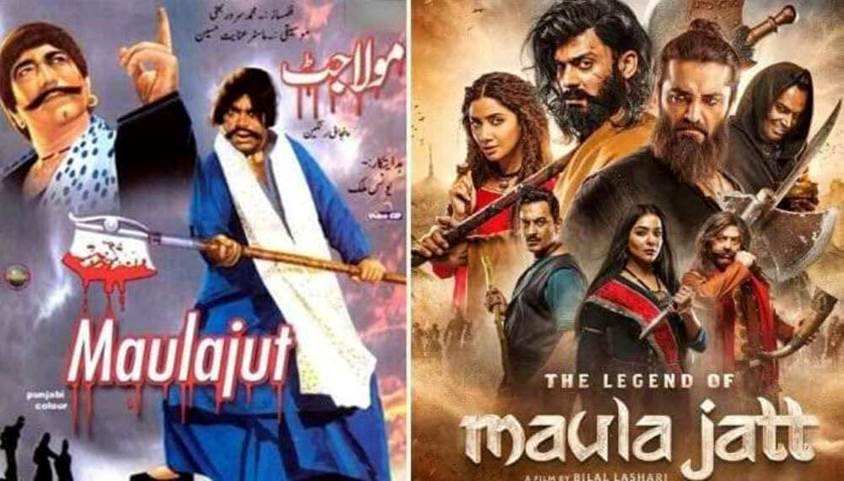
All Praise for The Legend of Maula Jatt
By Ras H. Siddiqui

The long wait was over as audiences worldwide finally got the opportunity to see Punjabi movie “The Legend of Maula Jatt” on the big screen in various cinemas around the globe, including America. We viewed it in Roseville, California at the Cinemark at the Galleria Mall on Sunday, October 16, 2022, and were not disappointed.
Not being Punjabi-speakers did not present a hurdle at all because people who speak and understand Urdu or Hindi will have little difficulty in understanding most of the dialogue in this film. For others, the English subtitles will certainly make things easier.
The Legend of Maula Jatt is a very loose remake or sequel to Maula Jatt, a 1979 Lollywood cult classic of the Punjabi Gandasa film genre. The Gandasa is a farming tool not exclusive to Pakistani Punjab but is equally, if not more, common in the Indian states of Punjab and Haryana. One can say that it is a “representative” tool of many Muslim, Sikh, and Hindu farmers of the region.
It looks like a very large axe on a long blade which was used to manually cut tough crops like sugarcane in the old days before mechanized farming. It can and has been used as a deadly weapon too in South Asia for many centuries. The Gandasa is also a mindset (hence the genre) that is reflective of a Punjabi or Haryanvi machismo. It describes men willing to fight to the death for land and honor, and the dignity of their Pagri (Pagg) or Turban. The idea is that each village or clan chief remains very proud of his Pagg and will use any physical means to protect it.
One more backdrop of this movie is necessary. It reflects a dipping into the “Spaghetti Western” film era of very successful movies (some starring Clint Eastwood), productions from the 1960’s and 70’s shot mainly in Italy or Spain. The Good, the Bad and the Ugly (1966) is one great example. But other possible links to the heart of this film may be found in the Japanese Samurai or Chinese Kung Fu genres which have already made their impact on worldwide audiences for many decades. There is always plenty of violence in such films and similar blood and gore is plentiful in The Legend of Maula Jatt. So, a word of caution. It could easily fit into the Halloween season of scary films too. This movie is not for kids and could have at least an “R” rating for the graphic violence shown in it.
Old fans of the historic blockbuster Bollywood film Sholay (1975) will like this movie too because it is like Sholay on steroids. There are major differences between the original Maula Jatt and this film too. Forty years does make a big difference in moviemaking. What Director Bilal Lashari has done here is nothing less than amazing. The cinematography and production quality, including sound is really the best to ever come out of Lollywood. Add to that a wonderfully and menacingly attractive cast and we have a winner here.
The film starts with romance and innocence interrupted by extreme violence at the hands of the Natt clan. We are quickly introduced to the past where a clan chief and Gandasa Warrior Sardar Jatt (Babar Ali) along with his wife Malika (Resham) are both outnumbered and brutally killed by the same nasty Natt clan. One survivor and witness to this killing is the couple’s young son Maula Jatt who is left with nightmares of the horror and becomes temporarily mute. He is saved by Ali (Zia Khan) and is adopted by a family in a nearby village where all have adapted themselves to living under the terror of the Natt’s by giving them anything they demand.
The Natt’s are led by Jeeva (Shafqat Cheema) but their actual power lies within the next generation, Maakha Natt (Gohar Rasheed), his sister Daaro (Humaima Malik) and the eldest, Noori Natt (Hamza Ali Abbasi), all reflections of pure evil. How evil are they? They are shown inhaling vapors from the extract of freshly crushed scorpions! And a bored Noori voluntarily stays in jail just to find some real combat competition there and awaits the day when someone stronger will finally defeat and kill him. Jaggoo (Nayyer Ejaz) is another strong character who leads the Natt army of ninjas.
On the other side are the good guys, protagonist Maula Jatt (Fawad Khan), his love interest Mukkho (Mahira Khan) and a brother from another mother Mooda (Faris Shafi). There are some other Buzdil (cowardly) villagers featured, helpless victims of the Natt’s. Also available for some light almost comic relief in this often-dark movie is Gogi (Ali Azmat) who tries to find some positives in often hopeless situations.
The stage is set. The few good guys who are willing to fight are outnumbered by the evil Natt’s. Fawad Khan as our powerful hero Maula, finally picks up his father’s Gandasa to fight. He does an incredible acting job in this movie while Mahira Khan’s character is not powerful (possibly intentionally so). She does it well but as one person commented, she could have looked more like a Punjaban in dress and hairstyle. Another friend sent in her comment that maybe there was some influence at play here from the Turkish drama series Ertugrul which has already captured the attention of international audiences.
This is a unique movie as the most powerful performances in it are by the nasty villains. Humaima Malik as Daaro and Hamza Ali Abbasi as Noori have literally stolen the show with their fine acting and deserve accolades. But this film is not without some positives either. It sends a short but strong message against female infanticide and contains a surprising promotion of the empowerment of women.
If the late Indian writer Khushwant Singh were alive today he would have appreciated the energy, love, wickedness, and sheer Punjabi power in this movie. In Maula and Noori he could have found two more candidates (I am stretching things here) for his “Nar Admi” (Macho Men) label. All one can add here is that thankfully their battle comes to us from the realm of fiction.
(Movie Rating 4.5 out of 5 stars).

